|
Michelle E. Chung |
*
EMAT6680 Final Assignment B: Ceva's Theorem |
|
Consider any triangle ABC.
Select a point P inside the triangle and draw lines AP, BP, and CP extended to their intersections with the opposite sides in point D, E, and F respectively.
- Explore (AF)(BD)(EC) and (FB)(DC)(EA) for various triangles and various locations of P.
- Conjecture? Prove it!
- Discuss how this theorem could be used for proving concurrency of the medians.
Concurrency of other special points?
- Explore a generalization of the result (using lines rather than segments to construct ABC) so that point P can be outside the triangle.
|
 |
1. Explore (AF)(BD)(EC) and (FB)(DC)(EA) for various triangles and various locations of P.
|
| Construction 1
: when point P is inside the triangle |
|
|
| 1. When triangle ABC is an OBTUSE triangle |
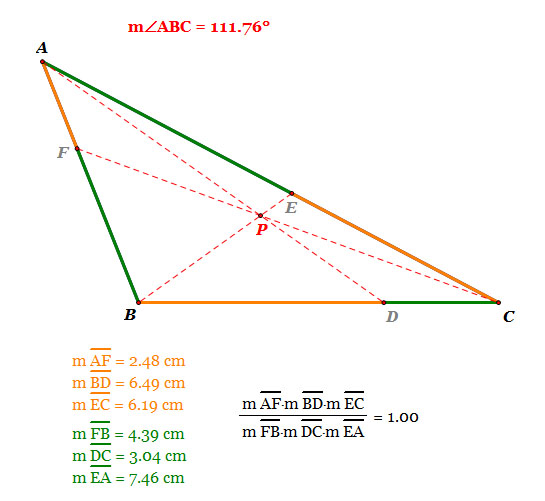
- As we see, when the triangle ABC is an obtuse triangle, the ratio of (AF)(BD)(EC) and (FB)(DC)(EA) is 1.
|
| 2. When triangle ABC is a RIGHT triangle |
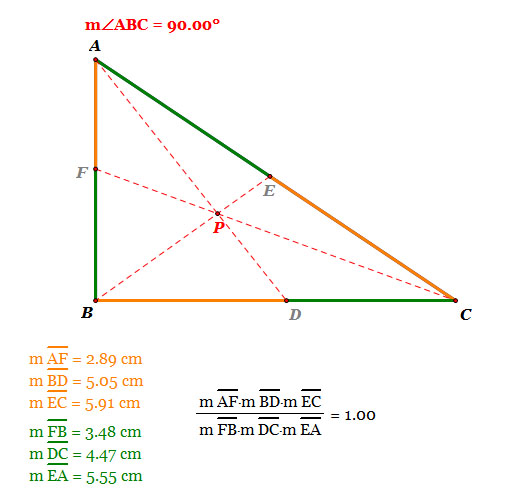
- As we see, when the triangle ABC is a right triangle, the ratio of (AF)(BD)(EC) and (FB)(DC)(EA) is 1.
|
| 3. When triangle ABC is a ACUTE triangle |
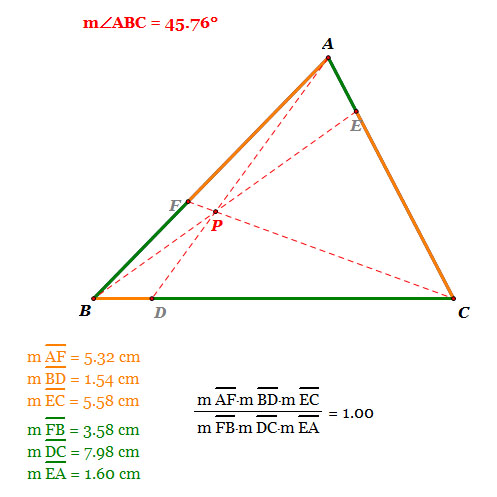
- As we see, when the triangle ABC is an acute triangle, the ratio of (AF)(BD)(EC) and (FB)(DC)(EA) is 1.
|
* If you want to see these in GSP movie, please click here. >>> Ceva's Theorem when P is inside
|
Construction 2
: when point D is moving |
| 1. When point D is on the side BC |

- As we see, when point D is on the side BC, i.e. point P is inside triangle ABC, the ratio of (AF)(BD)(EC) and (FB)(DC)(EA) is 1.
|
| 2. When point D is at the Left end point B |
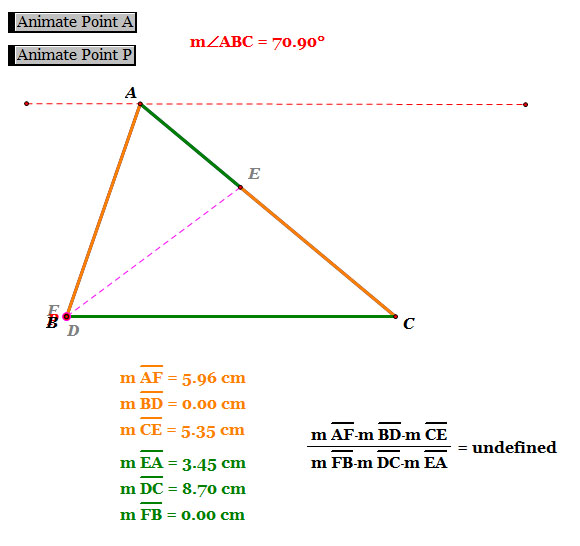
- As we see, when point D is at the Left end point B, i.e. point P is at the vertex of the triangle A, the ratio of (AF)(BD)(EC) and (FB)(DC)(EA) is undefined because the length of line segment FB is 0.
|
| 3. When point D is at the Right end point B |
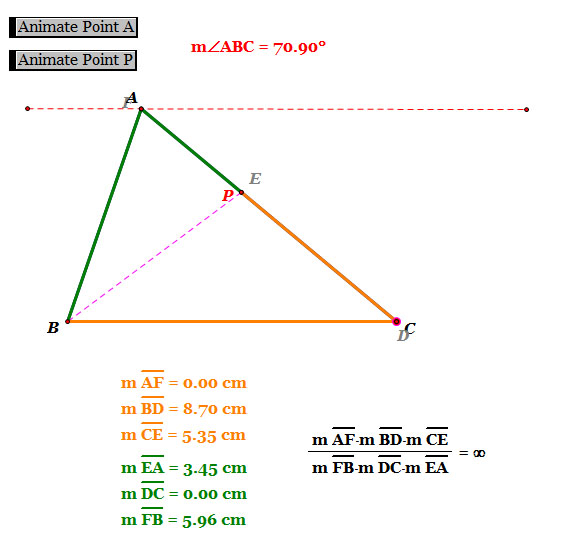
- As we see, when point D is at the Left end point B, i.e. point P is on the side of the triangle ABC, the ratio of (AF)(BD)(EC) and (FB)(DC)(EA) is infinity because the length of line segment AF is 0.
|
* If you want to see these in GSP movie, please click here. >>> Ceva's Theorem when D is moving
|
Conclusion
|
- When the point P is inside the triangle ABC, the ratio of (AF)(BD)(EC) and (FB)(DC)(EA) is always 1.
- When the point D is moving along the line segment BC, the ratio of (AF)(BD)(EC) and (FB)(DC)(EA) is
'1' if point D is on the side BC, i.e. point P is inside triangle ABC
'UNDEFINED' if point D is at the Left end point B, i.e. point P is at the vertex of the triangle
'INFINITY' if point D is at the Left end point B, i.e. point P is on the side of triangle ABC
|
Back to the Top |
2. Proof of Ceva's Theorem (when point P is inside of triangle ABC)
|
|
Construction |
|
|
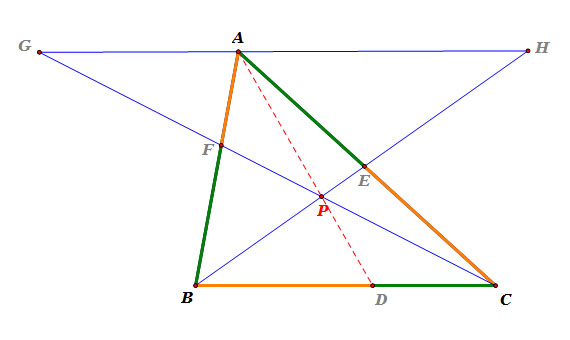
|
- Draw a line that parallel to side BC and passes through point A, and name it line k.
- Extend line segment CF, and find an intersecting point of line k and ray CF. Name the point as point G.
- Extend line segment BE, and find an intersecting point of line k and ray BE. Name the point as point H.
|
Step 1
: Use triangle EHA and triangle EBC |
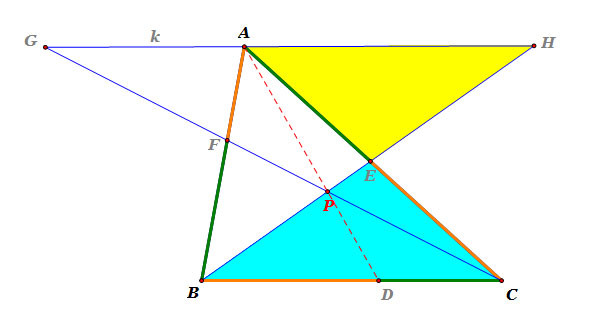
|
| |
Consider triangle AEH and triangle CEB.
Since line k and line segment BC are parallel and line segment AC and line segment HB are tranversal,
m( angle AHE) = m(angle CBE) <<< corresponding angles
m( angle HAE) = m(angle BEC) <<< corresponding angles
m( angle AEH) = m(angle CEB) <<< vertical angles.
So, triangle AEH and triangle CEB are similar.
Thus, m(line segment CE) : m(line segment AE) = m(line segment CB) : m(line segment AH),
i.e. m(line segment CE) / m(line segment AE) = m(line segment CB) / m(line segment AH).
|
Step 2
: Use triangle AGF and triangle BCF |
|
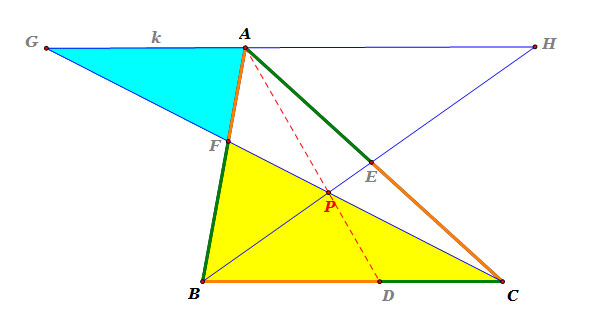 |
| |
Consider triangle AGF and triangle BCF.
Since line k and line segment BC are parallel and line segment GC and line segment AB are tranversal,
m( angle AGF) = m(angle BCF) <<< corresponding angles
m( angle GAF) = m(angle CBF) <<< corresponding angles
m( angle AFG) = m(angle BFC) <<< vertical angles.
So, triangle AGF and triangle BCF are similar.
Thus, m(line segment AF) : m(line segment BF) = m(line segment AG) : m(line segment BC),
i.e. m(line segment AF) / m(line segment BF) = m(line segment AG) / m(line segment BC).
|
Step 3
: Use triangle APH and triangle DPB |
|
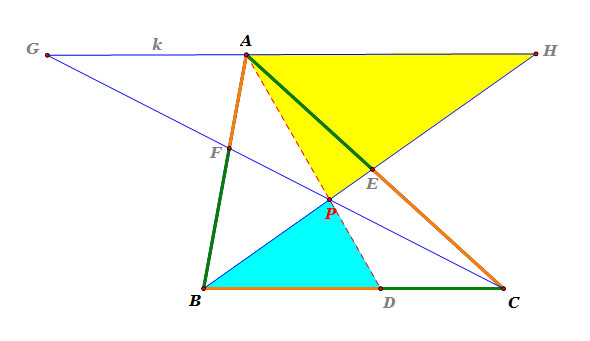 |
| |
Consider triangle APH and triangle DPB.
Since line k and line segment BC are parallel and line segment AD and line segment HB are tranversal,
m( angle AHP) = m(angle DBP) <<< corresponding angles
m( angle HAP) = m(angle BDP) <<< corresponding angles
m( angle APH) = m(angle DPB) <<< vertical angles.
So, triangle APH and triangle DPB are similar.
Thus, m(line segment AP) : m(line segment DP) = m(line segment AH) : m(line segment CB),
i.e. m(line segment AP) / m(line segment DP) = m(line segment AH) / m(line segment DB).
|
Step4
: Use triangle AGP and triangle DCP |
|
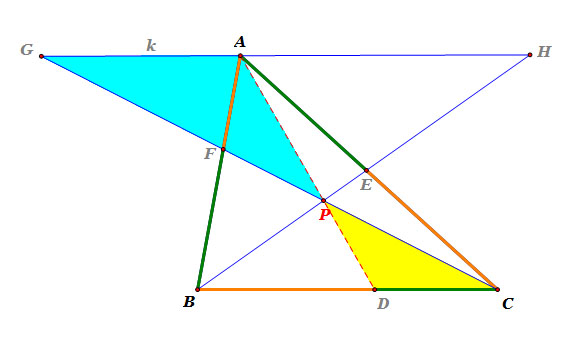 |
| |
Consider triangle AGP and triangle DCP.
Since line k and line segment BC are parallel and line segment AD and line segment GC are tranversal,
m( angle AGP) = m(angle DCP) <<< corresponding angles
m( angle GAP) = m(angle CDP) <<< corresponding angles
m( angle APG) = m(angle DPC) <<< vertical angles.
So, triangle AGP and triangle DCP are similar.
Thus, m(line segment AP) : m(line segment DP) = m(line segment AG) : m(line segment BC),
i.e. m(line segment AP) / m(line segment DP) = m(line segment AG) / m(line segment DC).
|
Step 5
: Use the proportions |
|
|
Since
m(line segment CE) / m(line segment AE) = m(line segment CB) / m(line segment AH)
m(line segment AF) / m(line segment BF) = m(line segment AG) / m(line segment BC)
m(line segment AP) / m(line segment DP) = m(line segment AH) / m(line segment DB)
m(line segment AP) / m(line segment DP) = m(line segment AG) / m(line segment DC),
[ m(line segment AF) * m(line segment BD) * m(line segment EC) ] / [ m(line segment FB) * m(line segment DC) * m(line segment EA) ]
= [ m(line segment AF) / m(line segment FB) ] * [ m(line segment EC) / m(line segment EA) ] * [ m(line segment BD) / m(line segment DC) ]
= [ m(line segment AG) / m(line segment BC) ] * [ m(line segment CB) / m(line segment AH) ] * [ m(line segment BD) / m(line segment DC) ]
= [ m(line segment AG) / m(line segment AH) ] * [ m(line segment BD) / m(line segment DC) ]
= [ m(line segment AG) /m(line segment DC) ] * [ m(line segment BD) / m(line segment AH) ]
= [ m(line segment AP) / m(line segment DP) ] * [ m(line segment DP) / m(line segment AP) ]
= 1
|
Back to the Top |
3. Proof of three Medians' Concurrency
|
Construction |
|
|
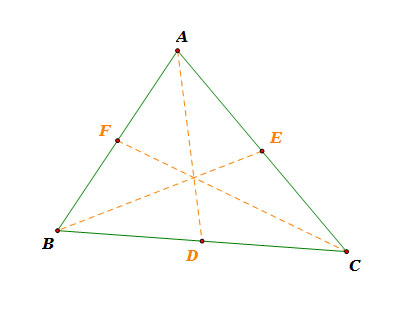
|
Proof |
There are three medians, line segment AD, line segment BE, and line segment CF.
Since m(line segment AF) = m(line segment BF), m(line segment BD) = m(line segment CD), and m(line segment CE) = m(line segment AE),
[ m(line segment AF) * m(line segment BD) * m(line segment CE) ] / [ m(line segment BF) * m(line segment CD) * m(line segment AE) ] = 1.
So, the three medians should intersect at one point, and that point is point P in Ceva's Theorem.
Hence, we can prove the concurrency of three medians from Ceva's Theorem.
|
| |
Back to the Top |
4. Proof of Ceva's Theorem (when point P is outside triangle ABC)
| Construction
for Ceva's Theorem
|
|
|
When the intersection of three Cevians, point P, is outside triangle ABC, the construction for Ceva's Theorem looks like this:
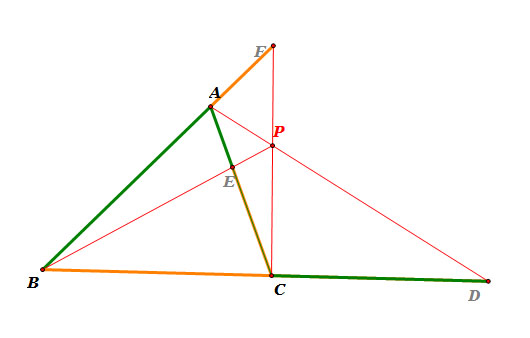
|
Construction for Proof |
 |
- Draw a line that parallel to side AC and passes through point B, and name it line k.
- Extend line segment DA, and find an intersecting point of line k and ray DA. Name the point as point G.
- Extend line segment FC, and find an intersecting point of line k and ray FC. Name the point as point H.
|
Step 1
: Use triangle DGB and triangle DAC |
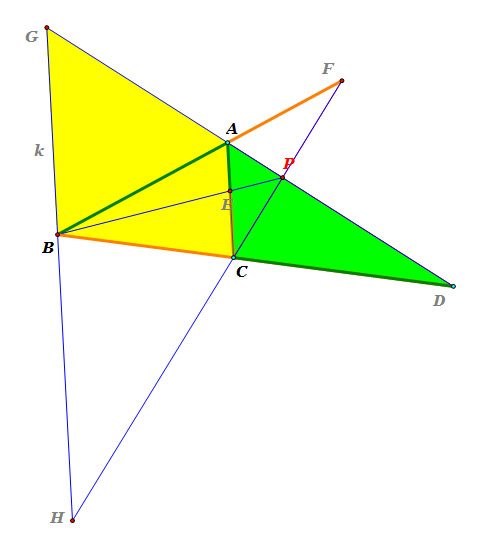
|
Consider triangle DGB and triangle DAC.
Since line k and line segment AC are parallel and line segment DG and line segment DB are tranversal,
m( angle DAC) = m(angle DGB) <<< corresponding angles
m( angle DCA) = m(angle DBG) <<< corresponding angles
m( angle ADC) = m(angle GDB) <<< common angles.
So, triangle DGB and triangle DAC are similar.
Thus, m(line segment BD) : m(line segment DC) = m(line segment GB) : m(line segment AC),
i.e. m(line segment BD) / m(line segment DC) = m(line segment GB) / m(line segment AC).
|
Step 2
: Use triangle FBH and triangle FAC |
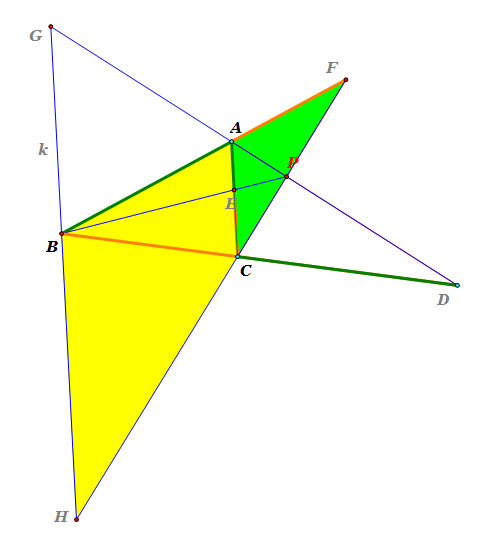 |
Consider triangle FBH and triangle FAC.
Since line k and line segment AC are parallel and line segment FB and line segment FH are tranversal,
m( angle FAC) = m(angle FBH) <<< corresponding angles
m( angle FCA) = m(angle FHB) <<< corresponding angles
m( angle AFC) = m(angle BFH) <<< common angles.
So, triangle FBH and triangle FAC are similar.
Thus, m(line segment AF) : m(line segment FB) = m(line segment AC) : m(line segment BH),
i.e. m(line segment AF) / m(line segment FB) = m(line segment AC) / m(line segment BH).
|
Step 3
: Use triangle PBH and triangle PEC |
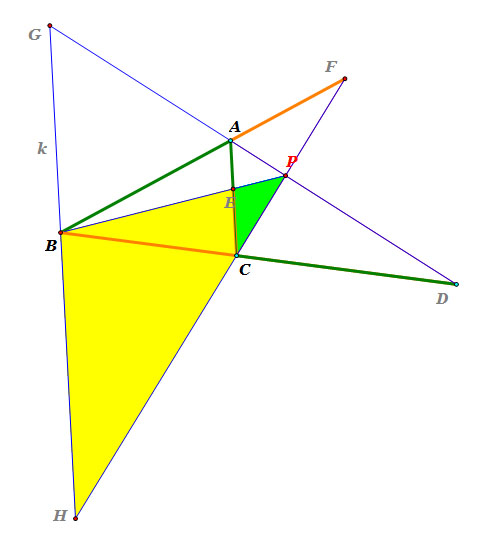 |
Consider triangle PBH and triangle PEC.
Since line k and line segment EC are parallel and line segment PB and line segment PH are tranversal,
m( angle PEC) = m(angle PBH) <<< corresponding angles
m( angle PCE) = m(angle PHB) <<< corresponding angles
m( angle EPC) = m(angle BPH) <<< common angles.
So, triangle PBH and triangle PEC are similar.
Thus, m(line segment EC) : m(line segment BH) = m(line segment PE) : m(line segment PB),
i.e. m(line segment EC) / m(line segment BH) = m(line segment PE) / m(line segment PB).
|
Step 4
: Use triangle PGB and triangle PAE |
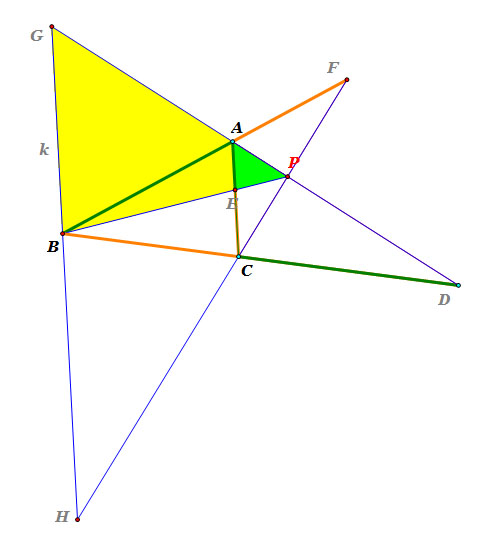 |
Consider triangle PGB and triangle PAE.
Since line k and line segment EC are parallel and line segment PG and line segment PB are tranversal,
m( angle PAE) = m(angle PGB) <<< corresponding angles
m( angle PEA) = m(angle PBG) <<< corresponding angles
m( angle APE) = m(angle GPB) <<< common angles.
So, triangle PGB and triangle PAE are similar.
Thus, m(line segment GB) : m(line segment AE) = m(line segment PB) : m(line segment PE),
i.e. m(line segment GB) / m(line segment AE) = m(line segment PB) / m(line segment PE).
|
Step 5
: Use the proportions |
Since
m(line segment BD) / m(line segment DC) = m(line segment GB) / m(line segment AC)
m(line segment AF) / m(line segment FB) = m(line segment AC) / m(line segment BH)
m(line segment EC) / m(line segment BH) = m(line segment PE) / m(line segment PB)
m(line segment GB) / m(line segment AE) = m(line segment PB) / m(line segment PE),
[ m(line segment AF) * m(line segment BD) * m(line segment EC) ] / [ m(line segment FB) * m(line segment DC) * m(line segment EA) ]
= [ m(line segment AF) / m(line segment FB) ] * [ m(line segment BD) / m(line segment DC) ] * [ m(line segment EC) / m(line segment EA) ]
= [ m(line segment AC) / m(line segment BH) ] * [ m(line segment GB) / m(line segment AC) ] * [ m(line segment EC) / m(line segment EA) ]
= [ m(line segment GB) /m(line segment BH) ] * [ m(line segment EC) / m(line segment EA) ]
= [ m(line segment GB) /m(line segment EA) ] * [ m(line segment EC) / m(line segment BH)]
= [ m(line segment PB) / m(line segment PE) ] * [ m(line segment PE) / m(line segment PB) ]
= 1
|
|
 Go Back to Top Go Back to Top |
 Go
Back to Michelle's Main page
Go
Back to Michelle's Main page |
 Go
Back to EMAT 6680 Homepage
Go
Back to EMAT 6680 Homepage |
Copyright
@ Michelle E. Chung |


















